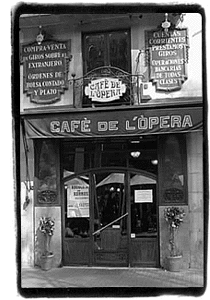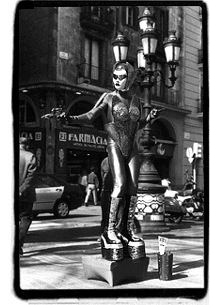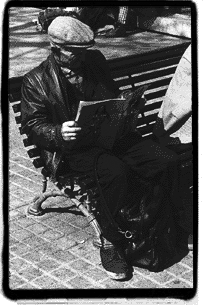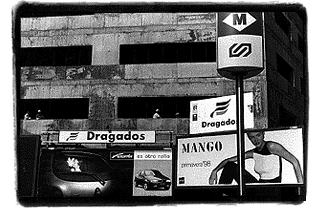
¡ Hola señor, señora ! ¿ Hablas Inglès ? Barcelona... the most inviting city I've been to yet, with lots of contrasting things and a well for inspiration. As the centre of a powerful metropolitan region and the capitol of Catalonia, it's the city of Gaudí and modern architects. City of designers and artists. Barcelona is undoubtedly the most trendy city of Spain.
Barcelona is a city engaged in a continuous process of renewal and improvement that results in day-to-day gains in the quality of life. It has a rich cultural heritage of its two thousand year history, the reality of the present an the hopes of the future. Strolling through the streets and squares, you can enjoy the Roman walls, the Gothic Quarter, the architecture of the Eixample, the Modernism of Antonio Gaudí and work of Pablo Picasso and Joan Miró. And on top of that, the city has excellent facilities, modern services and its gastronomy is outstanding!
When I first visited Barcelona in December 1995 (I went back in April 1998 and in May 2000), I bought a cheap airplane ticket and made reservations for a room in the oldest part of the city, Barri Gòtic, near the seaside. It took about 20 minutes from the Barcelona airport to the Plaça Catalunya (blue tourist bus). From Plaça Catalunya I walked through the Barri Gòtic to my hotel. It turned out to be an excellent choice. Hotel Metropol (Ample 31)- en el corazón de Barcelona- is a nice, quiet hotel and a perfect base for several reconnoitering expeditions. I didn't know what to expect of this city, except that it had a rich history of "Art Nouveau" and that the architect Antoni Gaudí has created some beautiful, organic buildings within and around the centre.

Because of the position of my hotel, I started to scout this neighbourhood first. When I faced the sea from the top of the Ramblas, at Plaça Catalunya, the historical centre, known as Ciutat Vella, is in front of me. This is Barcelona's Old Town that's built around La Seu Santa Eulalia, a Gothic cathedral. It forms a quarter that is both monumental and picturesque. It's also a quarter of quaintly narrow winding streets and public squares of ludicrously small dimensions. If it is necessary to stroll through a city in order to really appreciate it, strolling is unquestionably enjoyable necessity in Ciutat Vella. Needless to say, no one should fail to saunter down the full length of La Rambla. This street runs straight through the Barri Gòtic. At any time of day this boulevard contains a mixture of native Barcelonans, tourists from around the world, street musicians and performers. There's a lot of activity around the many newspaper-kiosks, flower and pet shops. It looks like everybody uses this street to go to work or make an appointment with his or her friends on a terrace underneath the big plane-trees. One should certainly not miss the shop-porch ornamented with sumptuous mosaics, enherited from the Barcelonan Jugendstil period (Pastas Alimenticias) and the Mercat La Boqueria, a lively covered market place. A small street off the Ramblas, near the cosy cafè de l'Òpera, a perfect place for a cafè amb llet, leads to the magnificent Plaça Reial where once stood a Franciscan cloister. Nowadays it's a nice square with lots of terraces, a fountain and big waving palm-trees.
Near the Ramblas, in a spacious square amid a maze of quaint little streets, stands the Museo d'Art Contemporani de Barcelona (MACBA), a colossal white building designed by the famous architect Richard Meier. The building (Plaça dels Àngels s/n.) itself is worth while visiting! In my humble opinion, this is the perfect concept for a museum of contemporary art.

Wether you just feel like a drink, after strolling through those narrow streets, try Els Quatre Gats- a nicely refurbished establishment that was the cradle of the Art Nouveau movement in Barcelona. At the end of the 19th century this was the meeting place of a whole generation of great artists and bohemians, including Picasso, Casas, Nonell, Russinyol and others. Now, featuring the same classic decor, 4Gats has re-opened to offer people a fascinating ambience for dining (Montsió 3bis). Another very special establishment is Los Caracoles- which was founded in 1857. It is a typical spot with an outdoor grill. The counter in its entrance is the perfect place to have a drink while waiting for a table. Its dining rooms, covered with lots of photographs of famous international people who've been there, and private halls inside, together with its exquisite attention to diners, make this a good choice for any visitor who wishes to enjoy Catalan cooking in a unique setting (Escudillers 14).
Seeing Barcelona's seafront for the first time, I might conclude that the city is quite fond of this area. With the holding of the Summer Olympics in 1992, the city built the Olympic Harbour, rehabilitated the run-down facilities of the Port Vell (Old Port). In the heart of this fishermen's quarter lies Moll d'Espanya. This former wharf, where merchant ships used to be loaded and discharged, is reconstructed with new seaside promenades, shopping and recreational centres, museums, cinemas (IMAX), a wide variety of shops, musical bars and restaurants. In its centre stand the Maremagnum complex, a large space of innovative design with a beautiful square where water sets the keynote. Together with the Aquarium, a recreational-educational facility with twenty large tanks and a central core formed by the Oceanarium (the largest in Europe), Barcelona's seafront is the favourite area among locals and a place that should not be missed while visiting. Especially on weekends, all these places fill up with local inhabitants and people from other towns, who are eager to spend an enjoyable evening by the sea to the sound of the latest hits. All this in a city where one may sit at a terrace to drink or dine over three hundred days a year. This area is marked by quality offering of gastronomy and squares studded with world-class design architecture. And this should be enough for day one, I guess.
When I returned to Barcelona in April of this year, they told me that I should go look for a restaurant beside the seaside promenade on the way to the Port Olímpic or Olympic Harbour. This is nowadays the centre of one of the foremost leisure areas of the city, with countless bars and restaurants, On entering this area, you passes through a unique gateway formed by two skyscrapers. I suggest you make a reservation before going there. Check out Agua (Passeig Marítim de la Barceloneta 30), the most interesting of all these spots, I am told.
On my second day I went back to Plaça Catalunya from where I discovered the most important avenue of today, the Passeig de Gràcia, and its environment. Barcelona is known around the world for its celebrated painters and its Modernism, or what in other European cities was to be called "Art Nouveau" or "Jugendstil", whose typical traits are a variety of forms and a wealth of ornamentation. Modernism was the physical incarnation of a certain spirit, a state of grace, in the 15 years from 1895 to 1910. Nor was it mere chance that Barcelona, and Catalonia in general, was the only place in Spain where Modernism developed a strong local flavour and resulted in significant achievements. The Eixample, which occupies a large part of the centre of today's Barcelona, is the main focus of Art Nouveau buildings and monuments. Though Catalan Modernism encompassed all the arts, it was undoubtedly architecture that gave expression to its greatest genius and most successfully showed how the movement could bring together various currents. The fact that the zenith of Modernism coincided with the period of construction of the Eixample gave this district of the city a sense of richness and unity that is quite unique and considered to be the most important "Art Nouveau" urban ensemble in Europe. This extremely large district of the city is the site of the well-known trio; Casa Lleó Morera (Passeig de Gràcia 41)., Casa Amatller and Casa Batlló (Passeig de Gràcia 43)., which were respectively designed by the architects Domènech i Montaner, Puig i Cadafalch and Antoni Gaudí. Gaudí gave the whole building a decorative design based on organic shapes. Particularly impressive is the effect of the morning light reflecting on the numerous fragments of glass and ceramic embedded in the façade. The balconies and the rooftop feature shapes like masks and fish scales. The roof is topped by a kind of multi-coloured fish bone and also prominent is the organically-shaped cross crowning the well of the spiral staircase. The stained glass features many circular pieces in relief and the multi-coloured glass is lined with lead. If you got the change, try to have a look inside too.
 A little further on the Passeig de Gràcia, on the other side, you can find another singular masterpiece of Gaudí, Casa Milà (Passeig de Gràcia 92), nicknamed La Pedrera, literally "the stone quarry", due to the appearance of its majestic façade. La Pedrera was built between 1906 and 1912, at the peak of Gaudí's career, when he had firmly established his architectural mode of expression and formulated the aesthetic that was to characterize him definitively. La Pedrera has a structure of arcades, one above the other, attached to the rest of the building by wrought-iron girders within the stone. It's an organically expressive architecture, endowed with great plasticity and formal richness, which has become one of the most characteristic symbols of the city of Barcelona. When passing this way it is a good idea to enter La Pedrera. The doors, furniture, wrought-iron grilles and railings, locks, ornamental motifs on the ceilings and walls, elevator cages, tiles, gragolyes, etc... all the details and finishes, supervised directly by Gaudí, bear witness to his attention to create a total work of art. If you go up to the terrace on the rooftop, built at several levels linked together by steps, you can see it is dotted with a number of ceramic-coated chimneys and ventilation towers of nearly anthropomorphic shapes which often bring to mind medieval warriors. An exhibitions offers the visitor a comprehensive and truly fascinating view of the whole scope of Antoni Gaudí's work. This is an essential place to visit for anyone interested in the life and work of some of the outstanding figures of world architecture.
A little further on the Passeig de Gràcia, on the other side, you can find another singular masterpiece of Gaudí, Casa Milà (Passeig de Gràcia 92), nicknamed La Pedrera, literally "the stone quarry", due to the appearance of its majestic façade. La Pedrera was built between 1906 and 1912, at the peak of Gaudí's career, when he had firmly established his architectural mode of expression and formulated the aesthetic that was to characterize him definitively. La Pedrera has a structure of arcades, one above the other, attached to the rest of the building by wrought-iron girders within the stone. It's an organically expressive architecture, endowed with great plasticity and formal richness, which has become one of the most characteristic symbols of the city of Barcelona. When passing this way it is a good idea to enter La Pedrera. The doors, furniture, wrought-iron grilles and railings, locks, ornamental motifs on the ceilings and walls, elevator cages, tiles, gragolyes, etc... all the details and finishes, supervised directly by Gaudí, bear witness to his attention to create a total work of art. If you go up to the terrace on the rooftop, built at several levels linked together by steps, you can see it is dotted with a number of ceramic-coated chimneys and ventilation towers of nearly anthropomorphic shapes which often bring to mind medieval warriors. An exhibitions offers the visitor a comprehensive and truly fascinating view of the whole scope of Antoni Gaudí's work. This is an essential place to visit for anyone interested in the life and work of some of the outstanding figures of world architecture.
One hardly need to mention that the architect Antoni Gaudí - and the few city blocks known as the Quadrat d'Or, literally the "golden square", make up an architectural monument that is worth special attention. By following 'the Modernism route' you get an excellent idea of Barcelona's "Art Nouveau". It suggests visits to fifty different buildings (the Montaner palace, the Thomas house, The Lamadrid house, the Llopis Bofill house, etc.) and you won't regret it, if you, of course, intend to walk. The only limitation is the visiting hours, but it is really worth while looking at the outside façades too.
There are certain times of day when you may hesitate between 'dining' or 'snacking', that is sitting down to a full meal or indulging in the favourite local pastime of nibbling on exquisite 'tapas'. In fact, the Passeig de Gràcia has become a paradise of these little titbits. The establishments serving quality 'tapas' are open from early in the morning till very late at night. Tapa Tapa (Passeig de Gràcia 44) was the pioneering 'tapa' bar in the area and is a favourite among connoisseurs. It offers over eighty original delectable varieties of these appetizers, which makes it sometimes hard to choose. Its creative combinations and quality ingredients have created a genuine passion for 'tapas' in this city (if you can read between the lines, you know I've been there often!). You must also pay a visit to the over 500 sq.m Qu Qu (Quasi Queviures). This 'tapa' bar (Passeig de Gràcia 24) is decorated in the classic style of grocery shop-wine cellars. The quality of its wide offering of Iberian and Catalan charcuterie, cheeses and patés, which are on sale at the shop counter, is complemented by its fresh-baked bread and its assortment of 'tapas', salads and omelettes. Hmm, I'm getting hungry again. Did I already mention Ba-ba-reeba and El Mussol?
 Besides beautiful buildings and delicious food you can also visit Vinçon (Passeig de Gràcia 96), the treasure trove of design on immense premises which form the ideal place to see the latest trends and purchase something unquestionably original. Barcelona's shopping line stretches right accros the Eixample. Beginning in Ciutat Vella, at La Rambla, it passes through Plaça Catalunya, turns up Passeig de Gràcia and Rambla de Catalunya, the city's two great boulevards. There's a wide-ranging array of fashion available in this area likewise includes brand name shops that have been especially conceived for young people, such as Mango and Spaghetti & Co, but you can also find many shops of prestigious Spanish designers.
Besides beautiful buildings and delicious food you can also visit Vinçon (Passeig de Gràcia 96), the treasure trove of design on immense premises which form the ideal place to see the latest trends and purchase something unquestionably original. Barcelona's shopping line stretches right accros the Eixample. Beginning in Ciutat Vella, at La Rambla, it passes through Plaça Catalunya, turns up Passeig de Gràcia and Rambla de Catalunya, the city's two great boulevards. There's a wide-ranging array of fashion available in this area likewise includes brand name shops that have been especially conceived for young people, such as Mango and Spaghetti & Co, but you can also find many shops of prestigious Spanish designers.
There are two restaurants in this neighbourhood I've not been to yet, but I certainly will next time I visit Barcelona. They were recommended to me by someone, so I went looking to the first one. In a small street between Passeig de Gràcia and Rambla de Catalunya you can find Tragaluz, situated in a noucentista mansion. On the first-floor hall, covered by glazed roof, is a restaurant where you can enjoy exquisite cooking based on Mediterranean ingredients and flavours. The ground floor has a wine counter, and a tepanyaki in the rear, where "moderately-priced" Japanese appetizers are served in a youthful ambience (Pg. de la Concepció 5). The second one lies on the Rambla de Catalunya and is called La Tramola. It is described as a pleasure for the palate and it has become a culinary landmark of the city for its outstanding service and delicious cooking. They also have a wide variety of tapas and beers.
As you turn right where the Passeig de Gràcia crosses the Avenguda de la Diagonal, you're one your way to find Antoni Gaudí's great masterpiece, the yet unfinished basilica Sagrada Família (Plaça de la Sagrada Família). The towers are particular awesome with the geometrical stylization that reaches the climax in their finials.
To the north of the Barcelona district of Gràcia lies an urban park (Carrer d'Olot). Gaudí planned and directed the construction of a garden suburb, the Park Güell (1900-1914), for Eusebio Güell, as infrastructure and facilities for a residential garden city based on English models. Park Güell was intended for sixty single-family residential living units, isolated in a sunny area in a country estate on the Montaña Pelada, in the Tres Turons district of Barcelona. The project, however, was unsuccessful and the park became city property in 1923. Still, it is one of Gaudí's most colorful and playful works even though it was never fully completed.
Two pavilions at the main entrance, the porter's lodge and the administration, complete the wall surrounding the park.These pavilions are of stone with roofs of Catalan vaults of flat-laid brick finished with pieces of broken ceramic called trencadís. The ceramic trencadís follows the sinuous geometric surfaces, a device which gives all of the park's ornamentation a unique beauty. Each of the roofs is crowned by a small dome and above all stands a tall, spiral-shaped towed adorned with colorful tile and topped with Gaudí's characteristic four-branched cross.
A grand stairway, divided by the oft-photographed mythological figure of a lizard, leads to the large hypostyle hall meant to be a local market for the use of the inhabitants of the park, and also to the large lookout plaza, which formed the roof of the market. The most outstanding element of the plaza is the balustrade and bench in combination, which set the limits of the plaza above the colonnade. The extraordinary balustrade-bench twists in serpentine manner to form winding courses, recesses, and small semi-enclosed areas where the facing of brightly colored trencadís creates a spectacular collage of color and texture. For the creation of this winding bench and the beautiful keystones of the hypostyle market place, Gaudí had the collaboration of the architect Josep Maria Jujol.
It is in Park Güell that references to historical styles have been abandoned by Gaudí, who now makes use of complex geometrical forms and the splendor of the colour and the finishes constitute the most specific aspect of the contribution of Gaudí to the Modernista blossoming of the turn of the century.
In the park stands the house which Gaudí had built for his own use, the work of his disciple Francesc Berenguer (1905). The house has since been converted into the Casa-Museu Gaudí. The museum has notable examples of furnishings designed by Gaudí as well as personal memorabilia. Park Güell was declared a place of World Heritage by UNESCO in 1984.
Because I always am very tired after a day walk through this fantastic city, I haven't noticed much of the nightlife yet. I only went to one nightclub, Nick Havanna (Rosselló 208). When I entered around 11:00 pm there were only a few people and when I left at 01:00 am it was very quiet. I asked the bodyguards at the entrance when the fun normally started and they assured me that it would be full-house at 3:00 in the morning. Another way of life...
I would like to visit Psicodromo one night. This should be a very large dance-temple, built within the former buildings of an old factory in the Poble Nou (Almogàvers 86).
To be continued.
This is a non-profit web page. All the establishments mentioned in this story are places I've been to and which I would like to recommend to the visitors of Barcelona.
Photos by Joël Neelen © April 1998. All Rights Reserved.
| Algeria, Tassili n'Ajjer | Greece, the Dodecanese | Greece, the Cyclades | Morocco, the Massif Sirwa | Morocco, the High Atlas |
| Cuba | India | Egypt | Yemen | Jordan | Myanmar | Peru | Turkey | Barcelona |